
In these times of low interest rates and depressed asset values, an opportunity has presented itself to take advantage of some key estate planning tactics. The combination of the current environment and a lifetime estate exemption amount that has reached $11.58 million per person in 2020, make it a great time to think about transferring wealth.
Why is this Environment Favorable for Wealth Transfer Planning?
Depressed Asset Values: Gifts are based on the fair market value on the date of the gift. When asset values are depressed, you can make gifts at a lower value, therefore, increasing the amount you could give in comparison to a few months ago. This gives you the ability to capture the gift at the current value and get any future appreciation out of your estate.
Low Interest Rates: Interest rates are also hitting historic lows. Low interest rates help create an environment where you can transfer wealth with little or no gift tax consequences using certain estate planning tactics discussed below. The interest rate provides the hurdle over which investments must grow, so this essentially allows you to freeze the value of the assets and transfer the appreciation to future generations. Mandated IRS rates are as low as, or even below, 1% at present times.
High Estate Exemption Amount: Everyone can pass up to $11.58 million tax-free during his or her lifetime. This means a couple can transfer up to $23.16 million tax-free. These exemption amounts are set to sunset back to between $6 and $7 million in 2026. There is also the possibility that legislation could impact this prior to 2026.
Estate Planning Tactics to Consider
Annual Gift Exclusion: You can give up to $15,000 tax-free in any given year to each individual. Using assets that have declined in value in recent times could be good assets to gift while the values are lower (though assets with losses should not be gifted, as the basis resets to fair market value).
Intrafamily Loans: Loans can be made to children at a very low, interest-only rate. If the assets purchased with the loan funds appreciate more than the interest rate, the excess above the interest rate passes tax free. Additionally, we mentioned above that individuals can give up to $15,000 per person tax-free annually, so this amount could be used to forgive the loan over time. It is also a good time to consider refinancing any existing intrafamily loans to a lower rate.
Charitable Lead Annuity Trust (CLT): A CLT is a trust that provides a stream of distributions annually to a designated charity (including donor advised funds) over a term of years. At the end of the term, the remaining assets are distributed to designated beneficiaries, such as your children. CLTs use the 7520 rate to help calculate the remainder interest, so these can be structured with little or no gift tax implications and can benefit both a charitable organization and the named beneficiaries of the trust.
Grantor Retained Annuity Trust (GRAT): A GRAT is a strategy where assets that are expected to appreciate over time are transferred to an irrevocable trust. The individual (“Grantor”) who makes the transfer receives an annuity over a certain period. GRATs can be structured so that there is no gift tax consequence and anything remaining in the trust that grew above the 7520 rate, and after annuity payments are made at the end of the term, passes tax-free to the beneficiaries (or remain in trust for the beneficiaries).
Spousal Lifetime Access Trust (SLAT): A SLAT is an irrevocable trust that benefits your spouse and children. This allows you to transfer property and utilize your estate exemption at the current values, but still allows your spouse to have access to these assets if necessary.
Installment Sale to an Intentionally Defective Grantor Trust (IDGT): This is a tactic to sell assets to an irrevocable trust in exchange for a promissory note. The loaned assets are both income tax-free for the beneficiaries, and the appreciation over the interest rate also grows free of gift tax. The grantor retains the promissory note accruing at a low interest rate in his or her estate and pays the taxes on the income generated within the trust, but the appreciation and future cash flow remains out the estate tax-free.
Gifting Interest in Business, LLC, or Family Limited Partnership: As businesses or underlying assets may have been impacted by market volatility, gifting assets while values are lower can help maximize assets passed.
Swapping Trust Assets: Some irrevocable trusts allow for swapping assets in and out of the trust. This may be a good time to swap assets into the trust that have a high potential for growth.
In Summary: There are many estate planning strategies that have arisen as a result of the current environment. This is a great time to evaluate whether it makes sense to reduce your estate or accelerate family gifting. While, these strategies are worth considering, they are not for everyone. Consult with your financial advisor, CPA, and attorney to determine if these are appropriate for you.
THE 8 STEPS TO FINANCIAL READINESS
Make the most of your wealth now and in the future while assessing challenges, opportunities, and risks along the way. That way, you can grow, protect, give, and live your wealth in a way that aligns with what matters most: your Net Worthwhile®.
THE 8 STEPS TO FINANCIAL READINESS
Make the most of your wealth now and in the future while assessing challenges, opportunities, and risks along the way. That way, you can grow, protect, give, and live your wealth in a way that aligns with what matters most: your Net Worthwhile®.






